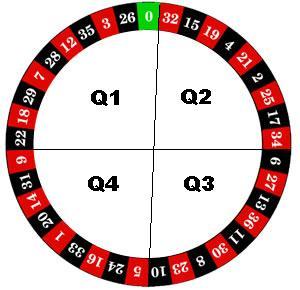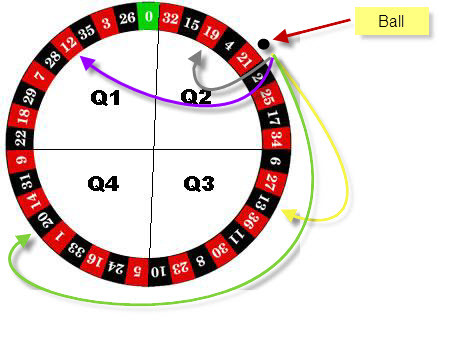Thanks to all for taking active interest in my query.
@forester
wow, from what I read I assume that the device will be a little bit difficult to find : :
: :
:
@bagun
The key isnt in knowing or finding a system,technique thats 100% proof and that will work every time on every wheel which it wont and doesnt exist . Its about knowing how to find and beat the conditions on a specific wheel.
Thanks for highlighting this out along with ur views mentioned in above four points. Yes, I agree in online live roulette NMB is called before the ball is spun and I also agree with the video latency u mentioned about. Keeping in mind “Its about knowing how to find and beat the conditions on a specific wheel.” I would like to share a little program that I made, a slight similar thing is mentioned in a video here genuinewinner.com/vb.html. This is very basic approach and I am really interested in improving it with help of experts here…
Starting first as you can see in following figure I have divided the roulette wheel in 4 Quadrants as Q1,Q2,Q3 and Q4.

Q1: 22-0 (10 pockets)
Q2: 32-34 (9 pockets)
Q3: 6-10 (9 pockets)
Q4: 5-9 (9 pockets)
The objective of the program is to find the forbidden quadrant among the above mentioned four for every spin (using separate databases for each anticlockwise (AW) and clockwise (CLW) spin)
Method:
Taking note of every spin consistently, software records the reference pocket (the pocket where the ball is before spin) and destination pocket (the pocket where the ball is after spin), calculates distance i.e. number of pockets between reference and destination in clockwise direction and saves the distance value to database respectively.
For example: If the history of wheel is as below starting at 0 as occurrence of rotar’s AW spin… further 19 as rotar’s CLW spin etc..
0,19,6,27,8,5,12,16,25
the software reflects values as Q1:1,Q2:1,Q3:1,Q4:0 for next rotar’s CW spin…
Working:
Since initially the ball is at 0 and the rotar is moving AW we take 0 as reference number for next rotar’s CLW spin. Spin… the ball stops at 19, so calculating distance we get number 19 is three pockets away from 0 so the CLW database gets its first value as “3”. Now pocket 19 will be reference pocket for next AW spin. Spin… ball stops at 6. Number 6 is seven pockets away from 19 so the AW database gets its first value as “7” and so counts the respective values on and on and on for several hundreds of consecutive spins and keeps track of all the distance values for AW and CLW spins separately.
Now say we have successfully recorded 100 spins (50 CLW + 50 AW) , and the ball is in pocket 21 (see figure below) and the next would be rotar’s AW spin…now lets say we have 15 records of distance value as “7” (yellow), 5 records for value “19”(green),15 records for value “28”(violet) and 15 records for value “35”(gray) in our AW database then, the software will show
Q1: 15
Q2: 15
Q3: 15
Q4: 5

So the quadrant with lowest value is forbidden. and bets are placed on number in Q1,Q2,Q3.
If betting unit is $1 then,
15+15+15 = 45 times I will win $8 ~ $360
and 5 times I will loose $28 ~ $140
i.e. $220 gain for every $1400 bet
i.e. $15.71 for every $100 bet ~ 15.7% advantage for this particular spin based on previous history.
Now, advantage for each spin may differ from spin to spin , CLW to AW etc… however if we consider to bet against “perfect” roulette wheel and so bet on Q1,Q2 and Q3 its certain that we win 75.68% and loose 24.32% of our bets so next thing I calculated is cumulative winning percentage (means how many times i really won applying the above quadrant method) so any value you get above 75.68% is reducing house advantage actually.
So for example say I am getting 3% advantage for next rotar’s CLW spin but I observed that the cumulative winning percentage for clockwise rotar spins is below 75.68% then I won’t bet.
Its about knowing how to find and beat the conditions on a specific wheel.
So I will wait for the spin with advantage along with cumulative winning > 75.68
I know there is lot of scope here for improvement here, member’s opinions, views, any ideas, suggestions regarding this method is highly appreciated.
Thanks
![]()

